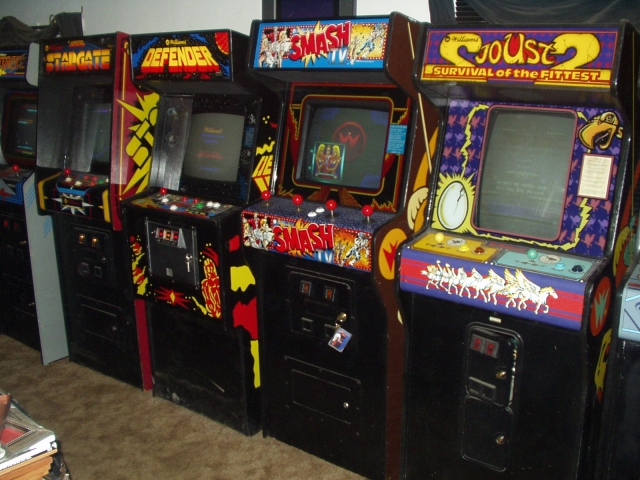
Arcade. Eyesore. It's Conquered - The state of the modern arcade.
Last week, I had a most disappointing time with games. I found myself visiting Namco Funscape at the Trafford Centre in Manchester, and like a child I approached this dedicated arcade with glee streaming from my face, overlooking the bizarre use of an umlaut in the title's 'u'.
Now, before I continue, I would like to make it abundantly clear I am not defaming Namco Funscape itself, nor it as a business model, its staff, its décor, or anything about it as its own entity. But from the moment I walked in there until long after I left I felt both depressed and angry at the realisation that arcades are dead – both in general, and to me personally.
I'm not so naïve that I didn't know this has long already been the case for the last 15 or so years, but it's been so long since I had set foot into a 'dedicated' arcade that I could still believe there were some still alive, preserved in a time bubble that people of my generation kept living both in style of venue (dark rooms, sticky floors, odours of flat fizzy drinks and chips in the air), and the games themselves (Street Fighter II, Point Blank, and Final Fight to name but several hundred).
That time bubble burst the moment I laid eyes on infinite 10p pushers, crane grabbers, fruit machines and horse race betting simulators. Has the fair come to town? Wading through these eyesores, taking up a lot of floor space in this fairly sizeable area, passing the Namco ticket-prize redemption counter (pretending that didn't exist!) I find myself face-to-face with the first of the few 'actual' arcade machines in the building... Doodle Jump.
But, to digress briefly, I note at this point that Namco Funscape is a dedicated arcade. Tenpin is a dedicated bowling company. The gaming venues I've been visiting over the past 15 years, living in places without such amenities as an arcade, I've had to make do with the flashy arcades tacked on to bowling alleys like Tenpin, Super Bowl, et al. Moving to Manchester I had the chance to see what passes for a real arcade these days, and then it hit me – the ones in the bowling alleys I'd grown accustomed to are the real arcades these days. The games are the same, and dedicated arcades now have bowling alleys tacked on to the side of them! The only difference between a bowling alley-arcade and an arcade-bowling alley is the Namco brand and ticket issuing allowing the potential to win yourself a prize for playing certain games. And it's not just bowling offered at this arcade, there's pool, an eatery and a bar too. If it wasn't for the dodgems hiding away in the corner – seriously, dodgems! - I would have assumed I'd wandered into a Tenpin by mistake.
Now, back to Doodle Jump. Or not, as the case is, as I just tutted at the mere concept of having an iOS game blown up onto a screen bigger than my own telly at home, and moved on to... sweet Jesus... Temple Run. I have to say I was intrigued by this, as I have wiled away a fair few hours on it at bus stops in the past, but looking at the rolling demo it barely looked much better than on my much inferior Galaxy S2... which I had on me... with Temple Run on it... which I downloaded for free. And Namco Funscape want me to pay £1 to play it, just for the novelty of swiping a trackball rather than the screen itself? Seriously, where are the actual, proper, bona fide ARCADE GAMES?!

Sure enough, I arrive at the hulking cabinets, the plastic vehicles and huge screens with guns hanging off them. Arcade stalwart Time Crisis is present, Time Crisis 4 to be precise, which I promptly stick a quid into, draw my weapon, only to put it back in the holster two minutes later due to too many face-entering bullets coming my way. There was an original Terminator Salvation machine, which looked ok, an arcade iteration of Codemasters' Grid, a sprawling 8-player setup of the latest incarnation of a personal beloved favourite of mine, Out Run, and Deadstorm Pirates. That was literally it. Profound sadness.
Let's travel back to the mid-90s, shall we? With the decline of arcades unknowingly on the horizon, they still drew immense crowds and businesses thrived solely on the takings eked out of the machines themselves. Up until the advent of the Sony PlayStation, Nintendo 64 and, I guess, the Sega Saturn, arcades were the showcase of technology that home gaming aspired to be. Often was the case a new game would appear in public cabinet form, and several pumped quids later a home version would appear, looking and playing worse than its coin-operated counterpart. But as home gaming technology picked up the pace, the arcades couldn't directly compete with home tech that not only offered for the first time the same level of graphical excellence, but also something a little deeper than your typical shooting, fighting or racing fare. The arcade industry began to collapse under the same gravity of advanced technology that it once embraced. Games were getting stories, customisation and longevity - requiring memory cards - and arcades simply couldn't vere from the 'how much game is worth £1?', instant gratification business model.
However, with all my moaning, whining, carping and querulousness, I haven't mentioned the one thing about arcades that haven't changed. The one thing that arcades ever existed for in the first place that they still offer today. Gone are the dank-floored, dimly lit basements, the crowds of children clambering around a cabinet trying to see first hand some kid perform Sub Zero's infamous decapitation fatality in Mortal Kombat. The classic arcade environment is gone, and being in awe at something new in the arcades is unlikely ever to happen again. What arcades still offer to the modern gamer to this very day, though, is the unique qualities to games. The ability to emulate what can't be done at home (still not counting Doodle Jump or Temple Run).

Before, it was a simple question of building a game within a cabinet that vastly outperformed what was possible in the home. The various home console versions of the Teenage Mutant Ninja Turtles coin-op is a testament to that. But as graphics, sound and just the games in general of the home left the arcades in their dust at breakneck speeds come the dawn of the new millenium, the arcades still today possess the space and money to offer to take you for a spin in a Ferrari Testarossa during a game of Out Run. 8-player local co-op racing. Light gun games how they're meant to be played – on a 72-inch screen with the sound turned up to 11. Sure, there hasn't been an original IP to have begun life in an arcade for Donkey (Kong)'s years, nor has there been an original title of any kind in nearly 20 years, that purpose of an arcade is dead.
Now simply a side attraction for other businesses, they do still enjoy life as a means to garner a unique method of playing games in an 'always-already-read' industry, and for that reason alone they should continue to live on for a little while longer. I have to just accept my childhood experiences of pumping enough 50ps into Final Fight until completion(!) are not coming back, and arcades had to adapt to the fast-changing, unforgiving world of technology or be lost forever.
I'd just like to see how they stand up to the forthcoming VR headsets and treadmills... an arcade Holodeck, perhaps?








COMMENTS
rik - 05:08pm, 4th August 2015
How much were the retro cabinets to play? I cant seem to hold much attention to games these days, apart from sc2. i always end up back on mame playing games from 1982 - 1988, trying to crush my personal hi scores